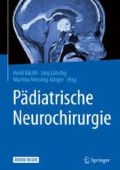Zusammenfassung
Das misshandlungsbedingte Schädel-Hirn-Trauma ist die häufigste nicht natürliche Todesursache im Säuglings- und Kleinkindesalter. Zumeist handelt es sich um ein Schütteltrauma (Shaken-Baby-Syndrom). Neben einer bewussten Gewaltanwendung sind auch affektbedingte Taten überforderter Eltern oder Aufsichtspersonen Ursache. Zumeist sind die Kinder klinisch schwer erkrankt. Die Mortalitätsrate liegt je nach Ausprägung zwischen 30–70 %. Neben einer zentralen Apnoe mit konsekutivem hypoxisch-ischämischen Hirnschaden spielen Subduralhämatome und -hygrome durch Brückenvenenabrisse und diffuse axonale Schäden eine bedeutende pathophysiologische Rolle. Die Prognose wird im Wesentlichen vom Ausmaß der globalen Hirnschädigung bestimmt. Überlebende Kinder tragen zumeist einen schweren hirnorganischen Schaden mit Zerebralparese, Erblindung und Epilepsie davon. Aus neurochirurgischer Sicht kommen die Ausräumung eines Subduralhämatoms sowie passagere oder dauerhafte Hirnwasserableitungen und eine multimodale Hirndrucktherapie zum Einsatz.
Literatur
Barlow KM, Minns RA (2000) Annual incidence of shaken impact syndrome in young children. Lancet 356(9241):1571–1572
Caffey J (1972) On the theory and practice of shaking infants. Its potential residual effects of permanent brain damage and mental retardation. Am J Dis Child 124(2):161–169
Caffey J (1974) The whiplash shaken infant syndrome: manual shaking by the extremities with whiplash-induced intracranial and intraocular bleedings, linked with residual permanent brain damage and mental retardation. Pediatrics 54(4):396–403
Duhaime AC, Gennarelli TA, Thibault LE, Bruce DA, Margulies SS, Wiser R (1987) The shaken baby syndrome. A clinical, pathological, and biomechanical study. J Neurosurg 66(3):409–415
Geddes JF, Whitwell HL (2004) Inflicted head injury in infants. Forensic Sci Int 146(2-3):83–88
Hymel KP, Willson DF, Boos SC, Pullin DA, Homa K et al. (2013) Derivation of a clinical prediction rule for pediatric abusive head trauma. Pediatr Crit Care Med 14(2):210–220
Hymel KP, Armijo-Garcia V, Foster R, Frazier TN, Stoiko M et al. (2014) Validation of a clinical prediction rule for pediatric abusive head trauma. Pediatrics 134(6):e1537–e1544
Jorch G, Poets CF, Herrmann B et al. (2014) Gefährdende Einflüsse aus Familie und Umwelt. In: Hoffmann GF, Lentze MJ, Spranger J, Zepp F (Hrsg) Pädiatrie. Springer, Berlin
Karibe H, Kameyama M, Hayashi T, Narisawa A, Tominaga T (2016) Acute subdural hematoma in infants with abusive head trauma: a literature review. Neurol Med Chir 56(5):264–273
Kempe CH, Silverman FN, Steele BF, Droegemueller W, Silver HK (1984) Landmark article July 7, 1962: The battered-child syndrome. JAMA 251(24):3288–3294
Lind K, Toure H, Brugel D, Meyer P, Laurent-Vannier A, Chevignard M (2016) Extended follow-up of neurological, cognitive, behavioral and academic outcomes after severe abusive head trauma. Child Abuse Negl 51:358–367
Matschke J, Herrmann B, Sperhake J, Korber F, Bajanowski T, Glatzel M (2009) Shaken baby syndrome: a common variant of non-accidental head injury in infants. Dtsch Arztebl Int 106(13):211–217
Mian M, Shah J, Dalpiaz A, Schwamb R, Miao Y et al. (2015) Shaken Baby Syndrome: a review. Fetal Pediatr Pathol 34(3):169–175
Minns RA, Jones PA, Tandon A, Fleck BW, Mulvihill AO, Elton RA (2012) Prediction of inflicted brain injury in infants and children using retinal imaging. Pediatrics 130(5):e1227–e1234
Punt J, Bonshek RE, Jaspan T, McConachie NS, Punt N, Ratcliffe JM (2004) The 'unified hypothesis' of Geddes et al. is not supported by the data. Pediatr Rehabil 7(3):173–184
Salvatori MC, Lantz PE (2015) Retinal haemorrhages associated with fatal paediatric infections. Med Sci Law 55(2):121–128
Vinchon M, Joriot S, Jissendi-Tchofo P, Dhellemmes P (2006) Postmeningitis subdural fluid collection in infants: changing pattern and indications for surgery. J Neurosurg 104(Suppl 6):383–387
Vitale A, Vicedomini D, Vega GR, Greco N, Messi G (2012) Shaken baby syndrome: pathogenetic mechanism, clinical features and preventive aspects. Minerva Pediatr 64(6):641–647
Author information
Authors and Affiliations
Corresponding author
Editor information
Editors and Affiliations
Rights and permissions
Copyright information
© 2018 Springer-Verlag Berlin Heidelberg
About this chapter
Cite this chapter
Messing-Jünger, A.M. (2018). Kindesmisshandlung . In: Bächli, H., Lütschg, J., Messing-Jünger, M. (eds) Pädiatrische Neurochirurgie. Springer, Berlin, Heidelberg. https://doi.org/10.1007/978-3-662-48700-6_56
Download citation
DOI: https://doi.org/10.1007/978-3-662-48700-6_56
Published:
Publisher Name: Springer, Berlin, Heidelberg
Print ISBN: 978-3-662-48699-3
Online ISBN: 978-3-662-48700-6
eBook Packages: Medicine (German Language)

